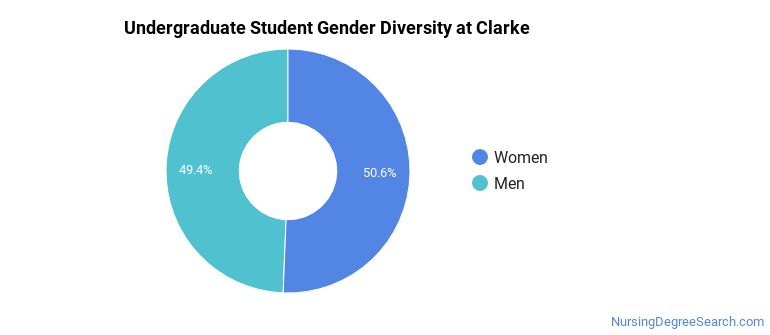Clarke University Nursing Programs
Clarke University is a private not-for-profit institution located in Dubuque, Iowa. The city atmosphere of Dubuque makes it a great place for students who enjoy having lots of educational and entertainment options.
Where Is Clarke University?

Contact details for Clarke are given below.
| Contact Details | |
|---|---|
| Address: | 1550 Clarke Dr, Dubuque, IA 52001-3198 |
| Phone: | 563-588-6300 |
| Website: | www.clarke.edu |
How Do I Get Into Clarke?
You can apply to Clarke online at: crm.clarke.edu/apply/
Admission Requirements for Clarke
| Submission | Required? |
|---|---|
| High School GPA | 1 |
| High School Rank | 3 |
| High School Transcript | 1 |
| College Prep Program | 3 |
| Recommendations | 3 |
| SAT or ACT Scores | 5 |
| TOEFL | 1 |
How Hard Is It To Get Into Clarke?
Approximately 82% of accepted students are men and 18% are women. The acceptance rate for men is 83%, and the acceptance rate for women is 94%.
Average Test Scores
About 5% of students accepted to Clarke submitted their SAT scores. When looking at the 25th through the 75th percentile, SAT Evidence-Based Reading and Writing scores ranged between 460 and 590. Math scores were between 460 and 570.
Can I Afford Clarke University?
The net price is calculated by adding tuition, room, board and other costs and subtracting financial aid.
Student Loan Debt
It's not uncommon for college students to take out loans to pay for school. In fact, almost 66% of students nationwide depend at least partially on loans. At Clarke, approximately 73% of students took out student loans averaging $12,504 a year. That adds up to $50,016 over four years for those students.
Clarke University Undergraduate Student Diversity

There are also 196 graduate students at the school.
Gender Diversity
Of the 634 full-time undergraduates at Clarke, 49% are male and 51% are female.

Racial-Ethnic Diversity
The racial-ethnic breakdown of Clarke University students is as follows.

| Race/Ethnicity | Number of Grads |
|---|---|
| Asian | 4 |
| Black or African American | 66 |
| Hispanic or Latino | 72 |
| White | 413 |
| International Students | 16 |
| Other Races/Ethnicities | 63 |
Geographic Diversity
Iowa students aren't the only ones who study at Clarke University. At this time, 15 states are represented by the student population at the school.
Over 11 countries are represented at Clarke. The most popular countries sending students to the school are United Kingdom, Venezuela, and Australia.
Clarke University Nursing Concentrations
The table below shows the number of awards for each concentration.
| Major | Bachelor’s | Doctor’s | TOTAL |
|---|---|---|---|
| Registered Nursing | 19 | 0 | 19 |
| Family Practice Nurse/Nursing | 0 | 8 | 8 |
| Psychiatric/Mental Health Nurse/Nursing | 0 | 0 | 0 |
| TOTAL | 19 | 8 | 27 |
References
*The racial-ethnic minorities count is calculated by taking the total number of students and subtracting white students, international students, and students whose race/ethnicity was unknown. This number is then divided by the total number of students at the school to obtain the racial-ethnic minorities percentage.
- College Factual
- National Center for Education Statistics
- Image Credit: By Namiba under License
More about our data sources and methodologies.
